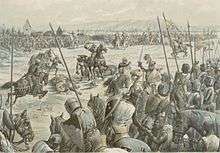Battle of Hausbergen
The Battle of Hausbergen took place on 8 March 1262 and marks the freeing of the city of Strasbourg from episcopal authority. The bourgeois of the town defeated the army of knights of the Bishop of Strasbourg, Walter of Geroldseck.
| Battle of Hausbergen | |||||||
|---|---|---|---|---|---|---|---|
 The Battle of Hausbergen by Emile Schweitzer, 1894 | |||||||
| |||||||
| Belligerents | |||||||
| City of Strasbourg | Bishop of Strasbourg | ||||||
| Commanders and leaders | |||||||
| Reimbold Liebenzeller, Nicolaus Zorn | Bishop Walter of Geroldseck | ||||||
| Strength | |||||||
| Unknown. Mainly militia on foot including 300 crossbowmen. Small number of horsemen. | 300 horsemen and at least 5000 infantrymen | ||||||
| Casualties and losses | |||||||
| Allegedly 1 (one) killed. [1] | Allegedly 1,300 footsoldiers and 70 knights killed, and 86 noblemen made prisoner.[1] | ||||||
Context
The relations between the Strasbourgers with their bishop, already strained, took a bad turn in 1260. As soon as he was installed on the episcopal throne, Walter of Geroldseck launched a manifesto of grievances against the citizens, stating his intention to re-establish, in all their rigor, his temporal rights as Count-Burgrave of Strasbourg. To do so, he threatened to use all the means of constraint conferred on him by his episcopal authority, foremost among which were prohibition and excommunication. Incidents between the bishop and the city multiplied and a test of force became inescapable.
Preparations for war
The bishop asked for reinforcements: 1,500 men from the Bishop of Trier, but also from the men sent by the abbots of St. Gall, Murbach, and above all Count Rudolf of Habsburg. He made a demonstration of strength in front of the city, which turned to his disadvantage. He then chose to put Strasbourg under blockade. The Strasbourgers tried in vain to break this blockade. 1261 proved a turning point. During a truce for the harvest, Rudolf of Habsburg changed sides and joined the city. The Strasbourgers proclaimed him the gonfalonnier of their army on 18 September 1261. At Christmas 1261, a sortie by the Strasbourgers with their new ally in the direction of Dachstein did not resolve the conflict, the bishop hesitating to clash with Rudolf. He avenged himself by plundering the possessions of Rudolf in Upper Alsace.
The battle
In the spring of 1262, Alsace was a scene of much violence and destruction.[2] Things came to a head on 8 March 1262. Half of the Strasbourg garrison, led by Reimbold Liebenzeller, went to Mundolsheim, at the northern end of the Hausbergen hill, to knock down the bell tower which was feared to be a lookout for the blockade established by the bishop. The bishop, based at Molsheim, was warned and set out with his army of 300 knights and 5,000 infantrymen.[3] Sighting the enemy approaching, Liebenzeller sent messengers to Strasbourg to call for help. He then climbed the hill of Hausbergen and awaited the troops, led by his colleague Nicolaus Zorn. When Zorn arrived, the combined force fell back toward the village of Oberhausbergen. The bishop, observing this, thought the army was trying to return to Strasbourg. Thinking to crush them with his cavalry before they escaped, he led his horsemen in a rapid advance, leaving his infantry to catch up as best they could. The Strasbourgers were not in flight, however, and deployed to face the bishop's men in good order.[4]
The battle began with a challenge to single combat by the knight Marcus of Eckwersheim from the army of Strasbourg. This was accepted by a knight called Beckelar of the episcopal army. Both parties were unhorsed but Eckwersheim was rescued by his comrades and Beckelar was killed.[4]
Immediately after this, the cavalry of the two sides clashed. The outnumbered Strasbourgers were having the worst of the struggle when Liebenzeller led forward the militia, armed with spears and Danish axes.[5] These were ordered to attack the horses of the knights. Meanwhile, Zorn had led the 300 crossbowmen out to the flank of the fight to engage the bishop's advancing infantry and prevent them interfering in the fight with the knights.[6] Such was the shooting of the bowmen that the infantry declined to advance further. Their cavalry was overwhelmed. Sixty knights were killed and another 73 captured.[7] The bishop was engaged in the struggle, having two horses killed under him before fleeing the field on a third. The bishop's brother, Hermann, lay among the dead.[6]
The bishop retired to Molsheim, abandoning his prerogatives over the city. He died in February 1263.
Consequences
Peace was concluded between the city and the new bishop, Henry of Geroldseck, cousin of the deceased Walter, confirmed on 21 April 1263 the complete independence of the Council. The past and future ducal pretensions of the Bishop of Strasbourg were declared null and inadmissible. Strasbourg was a free city of the Holy Roman Empire and its future was entrusted to its Council.
In addition, the management of the Notre-Dame Cathedral was taken from the bishop and entrusted to the cathedral chapter.
Commemoration
The 750th anniversary of the battle was celebrated in 2012. A comic album was published about the event and a seminar was organised by the University of Strasbourg.[8]
References
- Trendel, Guy. "La bataille de Hausbergen". Les Dernières Nouvelles d'Alsace.
- Delbrück, Hans (1990) [trans 1982]. History of the Art of War vol III; The Middle Ages. Translated by Renfroe, Walter. Westport, Conn.: Greenwood. p. 369. ISBN 0803265859.
- Bachrach, Bernard S.; Bachrach, David S. (2017). Warfare in Medieval Europe c.400-c.1453. Abingdon and New York: Routledge. p. 290. ISBN 9781138887664.
- Delbrück (1990), p. 370.
- Delbrück (1990), p. 372.
- Bachrach & Bachrach (2017), p. 290.
- Delbrück (1990), p. 371.
- "La bataille de Hausbergen : Strasbourg conquiert sa liberté". National and University Library. Retrieved 23 June 2017.